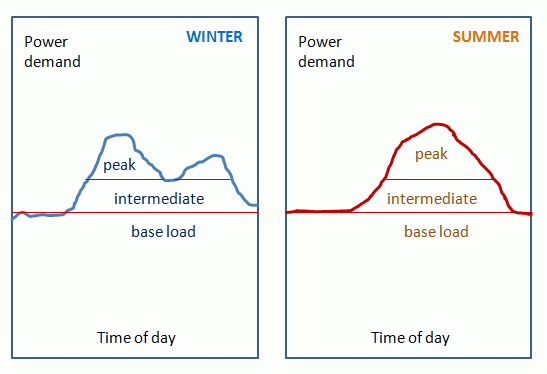9.1. Base Load Energy Sustainability
Base load power sources are the plants that operate continuously to meet the minimum level of power demand 24/7. Base load plants are usually large-scale and are key components of an efficient electric grid. Base load plants produce power at a constant rate and are not designed to respond to peak demands or emergencies. The base load power generation can rely on both renewable or non-renewable resources.
Non-renewable resources (fossil fuels) include: coal, nuclear fuels. Renewable resources include: hydropower, geothermal heat, biomass, biogas, and also a solar thermal resource with associated energy storage.
Typically, the power demand varies cyclically from day to day, reaching maximum during day business hours and dropping to minimum during late night and early morning, but never dropping below a certain base. (Figure 9.1) This base load is typically at 30-40% of the maximum load, so the amount of load assigned to base load plants is tuned to that level. The above-base power demand (above the base) is handled by intermediate and peak power plants, which are also included to the grid. The main advantages of the base load power plants are cost efficiency and reliability at the optimal power levels. The main disadvantages are slow response time, lack of fuel flexibility, and low efficiency when operated below full capacity.

Base load plants (as well as other energy converting facilities) are characterized by a nominal capacity rating. For example, if a plant rated at 1000 MW, it means it can generate 1000 MWh of electricity per hour when working at full capacity. The actual generation can be less, depending on the demand or operating conditions, and can be characterized by the capacity factor (CF):
CF = [actual generated output] / [maximum possible output]
For example, let us calculate the capacity factor for a 1000 MW base load power plant that generated 512,000 MWh of electricity over the month of January.
In this case, the maximum energy that can be generated by the plant at full capacity over this month can be determined as follows:
E(max) = 1000 MW x 31 days x 24 hour/day = 744,000 MWh
Then
CF = E(real) / E(max) = 512,000 / 744,000 = 0.69 (69%)
There are the number of reasons why a plant can have lower than 100% capacity factor. Some of them are:
- lower demand for electricity over certain periods of time;
- under-capacity operation due to maintenance;
- equipment failures / interruptions;
- resource/fuel shortage;
- equipment upgrade (resulting in high nominal capacity).
The base load power plants typically are coal-fueled or nuclear plants due to low-cost fuel and steady state power they can produce. Hydropower and geothermal power can also be used for base load electricity generation if those resources are regionally available.
The renewable energy systems, such as solar and wind, are most suitable for intermediate load plants. These are intermittent energy sources, with their output and capacity factor depending on weather conditions, daily, and seasonal variations. So, unless there is an effective energy storage system in place, they cannot be relied upon to meet constant electricity supply needs, nor can they be immediately employed to respond to peak demands. However, as intermediate sources, solar and wind systems can be efficient and can help reduce dependence on fossil fuels.
The peak power generation is usually attributed to the systems that can be easily stopped and started. Possibilities are natural gas and oil plants, hydro-facilities.
From the situation as it is right now, we can see that the niche of base load power is currently occupied by mainly non-renewable energy systems and therefore non-sustainable. But here is a probing question:
Can the base load power be entirely provided by renewable energy sources? Or we cannot avoid coal altogether?
Apparently, the difficulty with renewables is their intermittence in time and location bias. Comparison of typical capacity factors of various energy systems reflects this difficulty (see Table 9.1 below)
| Energy Conversion System | Capacity Factor % |
|---|---|
| Nuclear power | 90.3 |
| Coal | 63.8 |
| Natural gas | 42.5 |
| Hydroelectric | 39.8 |
| Concentrating solar | 33 (CA) |
| Wind | 20-40 |
| Photovoltaic solar | 15-19 |
In the table above, the lower the capacity factor, the more susceptible the system to potential interruptions or drops in performance. We can see that solar and wind technologies, which are notoriously weather-dependent have the lowest CF numbers. At the same time, nuclear power and coal systems are most advantageous when operated continuously and at full load.
To explore this question further, refer to the following readings:
Reading Assignment:
- Web article: Solar Power and Electric Grid /NREL. Energy Analysis
- Web article: Can Renewables Provide Baseload Power? / Skeptical Science, 2011
- Web article: Sunday Train: The Myth of Baseload Power / Daily Kos, 2013
Using the above-listed resources and other materials you may find on this topic, try to formulate answers to the following questions:
- Is it a realistic idea to use a mixture of renewable energy technologies to provide baseload power to the grid 24/7?
- What new technologies or engineering solutions would be required to pursue this idea?
At this point, we can see at least two major issues that make contemporary grid management more complicated: first is the efficient management of the baseload-peak variations and second is the incorporation of renewable energy systems. An array of new technologies and strategies that enable an information-based sensitive approach to electricity mass-market is summarized by the term smart grid, which is introduced in more detail in the next section.
Supplemental Reading on the Base Load Power:
Are Solar and Wind Really Killing Coal, Nuclear, and Grid Reliability? - The Conversation
Why Base Load Power is Doomed - Smart Planet
